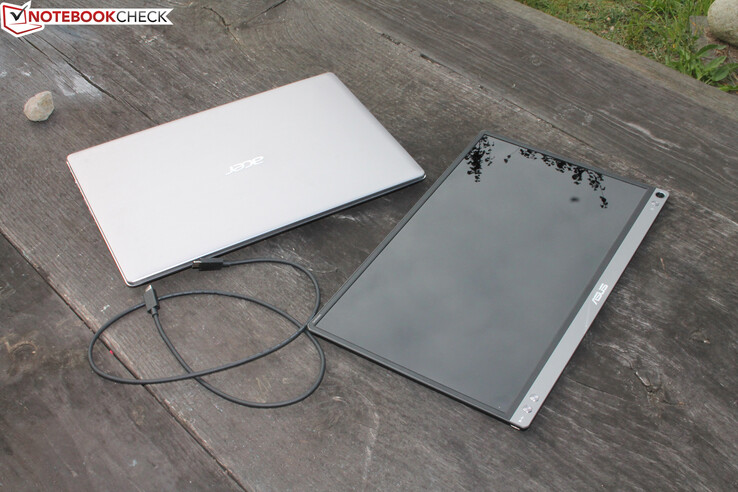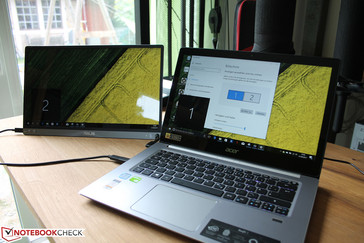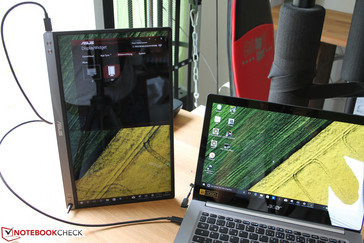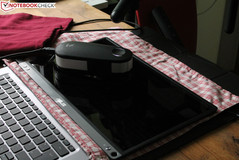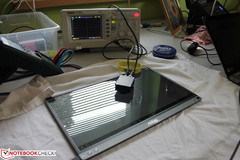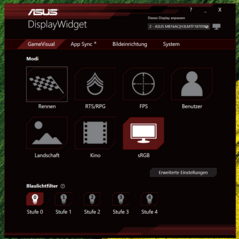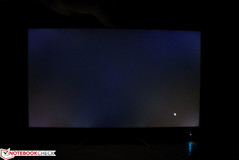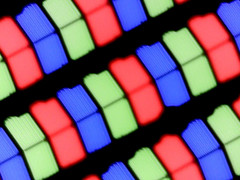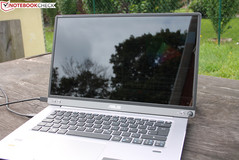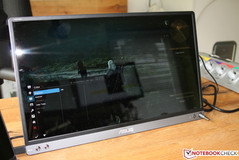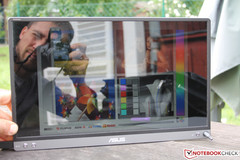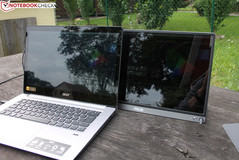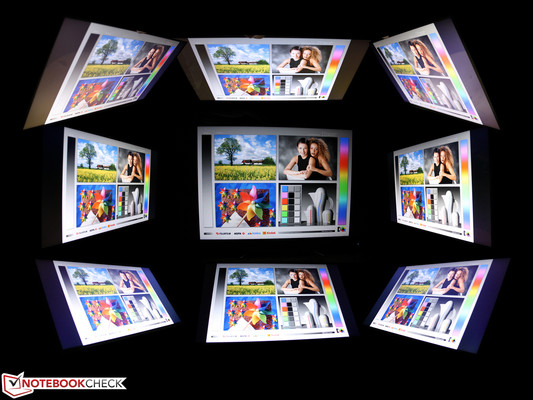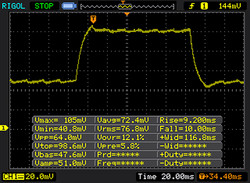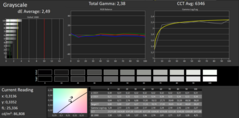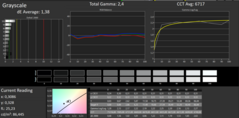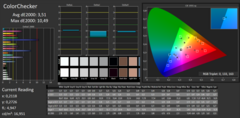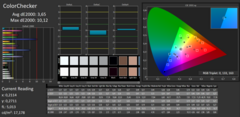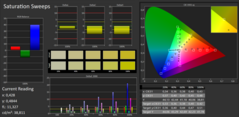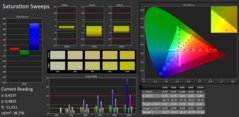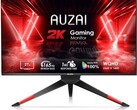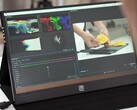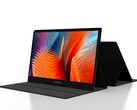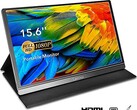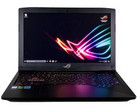Asus ZenScreen MB16AC (15.6, FHD, IPS) Monitor Review
For the original German review, see here.
With the ZenScreen MB16AC Asus has a portable monitor, the in its portfolio. It can boast with handy dimensions (360 x 226 x 8 mm/~14.2 x ~8.9 x 0.3 in) and low weight (780 grams/~1.7 lb). A USB 3.0 port in the laptop or convertible is the only thing needed for using the monitor.
The user has simply to connect a cable into the laptop's USB Type-C and it is ready to use. Windows 10 identifies the monitor extension immediately. A Type-C port is not present? No problem: The included adapter turns the Type-C to Type-A.
Case and Build
The ZenScreen has only a narrow, 8-millimeter (~0.3 in) bezel. Its weight of 780 grams (~1.7 lb) is comfortable to hold. The aluminum back (brushed) and aluminum lower edge make a solid and high-quality impression. The circular brushed pattern on the back follows that of the ZenBooks and is also found stylishly on the front's lower edge.
Software and Setup
DisplayLink is the technology behind video via USB. These adapters for connecting every monitor via a USB 2.0 port have been available since USB 2.0. USB docks have featured this technology and the tester has previously used such a dongle since VGA or HDMI was not available on his PC.
A disadvantage in the USB 2.0 past was a latency that was always more or less noticed in the mouse cursor or typing in Word in the worst case.
USB 3.0 has this issue under control thanks to higher bandwidths. However, USB monitors still have a relatively high latency and are thus not very useful for gaming, at least not for fast-paced games.
Software is not actually needed for running the ZenScreen. No matter whether via Type-C with Thunderbolt or a simple Type-A 3.0 port: Plug'n'play - Windows identifies the DisplayLink monitor. Nevertheless, we recommend installing the latest DisplayLink driver.
Like every external TFT, the ZenScreen has OnScreenDisplay (OSD). Using it with two buttons is tedious for the finger; we had to go back to square one every time we entered a character too many. Asus' DisplayWidget helps here. It is a tool that unites all OSD settings in one app. For example, the color profiles can be changed on the fly.
Contrast
The 15.6-inch monitor has a Full HD resolution common for this size, at least when we consider laptops of this size. This does not improve the surface much when connected to a 14-inch device. The MB16AC will probably be most useful in combination with 12 and 13-inch devices or when extending the desktop.
Asus' monitor achieves a contrast of 8300:1 on average thanks to the low black level of 0.02 cd/m², which is an excellent rate. It can clearly outperform good laptop screens with 1000:1 - 1500:1.
The illumination is relatively homogeneous. However, brighter corners can be seen after prolonged illumination, especially in the lower area (see screenshot).
| |||||||||||||||||||||||||
Brightness Distribution: 82 %
Center on Battery: 166 cd/m²
Contrast: 8300:1 (Black: 0.02 cd/m²)
ΔE ColorChecker Calman: 3.51 | ∀{0.5-29.43 Ø4.77}
ΔE Greyscale Calman: 2.49 | ∀{0.09-98 Ø5}
64% sRGB (Argyll 1.6.3 3D)
41% AdobeRGB 1998 (Argyll 1.6.3 3D)
Gamma: 2.38
CCT: 6346 K
| Asus MB16AC 1920x1080, 15.6" | Asus PB287Q 3840x2160, 28" | Lenovo ThinkPad P51 20HH0016GE LEN40BD, B156ZAN02.1, 3840x2160, 15.6" | Apple MacBook Pro 15 2017 (2.8 GHz, 555) APPA031, 2880x1800, 15.4" | |
|---|---|---|---|---|
| Display | ||||
| Display P3 Coverage (%) | 43.35 | 67.1 | 86.3 | 97.9 |
| sRGB Coverage (%) | 64.7 | 92.7 | 99.5 | 99.9 |
| AdobeRGB 1998 Coverage (%) | 44.84 | 67.8 | 99.3 | 85.9 |
| Response Times | ||||
| Response Time Grey 50% / Grey 80% * (ms) | 19 ? | 17 ? 5.2 ? | 40.8 ? | 48 ? |
| Response Time Black / White * (ms) | 28 ? | 7.7 ? 4.9 ? | 25.2 ? | 33.8 ? |
| PWM Frequency (Hz) | 25000 ? | 119000 ? | ||
| Screen | ||||
| Brightness middle (cd/m²) | 166 | 243 | 317 | 545 |
| Brightness (cd/m²) | 154 | 218 | 309 | 523 |
| Brightness Distribution (%) | 82 | 83 | 89 | 86 |
| Black Level * (cd/m²) | 0.02 | 0.28 | 0.36 | 0.44 |
| Contrast (:1) | 8300 | 868 | 881 | 1239 |
| Colorchecker dE 2000 * | 3.51 | 3.49 | 2.7 | 1.6 |
| Colorchecker dE 2000 max. * | 10.49 | 4.1 | 3.8 | |
| Greyscale dE 2000 * | 2.49 | 2.95 | 3 | 1.9 |
| Gamma | 2.38 92% | 2.2 100% | 2.27 97% | 2.26 97% |
| CCT | 6346 102% | 6811 95% | 6077 107% | 6834 95% |
| Color Space (Percent of AdobeRGB 1998) (%) | 41 | 60 | 87.6 | |
| Color Space (Percent of sRGB) (%) | 64 | 99.5 | ||
| Total Average (Program / Settings) |
* ... smaller is better
Outdoors and Brightness
The average brightness of just 154 cd/m² is disappointing. Such a low brightness was last measured in 2008 in some ThinkPads. Some of the listed external TFTs in the chart are not the brightest, but none is as dark as the ZenScreen.
A limited current to the USB port cannot be the reason for the low brightness. Type-C allows 3 amperes (15 watts) and USB 3.0/3.1 0.9 ampere (4.5 watts).
Thus, the ZenScreen cannot be used outdoors. It also has a glossy surface. However, the screen comes to its limits in dark gaming contents even indoors (see “Witcher 3” at 100% brightness).
Viewing Angles
PWM / Display Flickering
Fortunately, we did not determine backlight flickering in any brightness level in our tests. Apparently, Asus does not use PWM for controlling the backlight. Thus, prolonged use should not cause eyestrain or headaches.
Display Response Times
Color Reproduction
We use the CalMAN software in conjunction with our X-Rite i1Pro 2 photospectrometer for measuring color accuracy. The ColorChecker test determined a good yet not very good DeltaE 2000 rate of 3.5 in the standard settings. We measured this in the sRGB menu setting. The outcome of 3.65 was slightly worse after calibrating. The best screens in our test achieve a rate of 1 (e.g. Apple iPad Pro 12, 9/2017).
The grayscales of our review sample are a bit better and achieve a DeltaE 2000 rate of 2.5. However, the grayscale rates of almost all review samples are marginally higher than the ColorChecker average.
The monitor does not stand out at all with an sRGB color space coverage of 64%.
Verdict
With the ZenScreen MB16AC, Asus has launched a portable monitor on the market that convinces with handy dimensions (360 x 226 x 8 mm/~14.2 x ~8.9 x 0.3 in) and low weight (780 grams/~1.7 lb). The ZenScreen will not appeal to professionals: The limited sRGB color space is far from covered and the brightness thwarts any intention of using it on the terrace (glossy). On the other hand, the contrast is extremely high, which is ideal for videos, photo sessions or presentations as long as they take place indoors or in the evening.
Asus is not alone with the ZenScreen MB16AC. The manufacturer already had its portable 15-inch MB169B+ (220 Euros / $200) on the market in 2015. The ZenScreen is a bit more expensive, but it has a higher contrast and the (somewhat) smaller size. The weight is almost identical (780 vs. 800 gram/~1.7 vs ~1.76 lb).
Users who want it even smaller will find this in HP's EliteDisplay S140S. This 14-inch monitor costs 190 Euros/$300) but has a resolution of only 1600 x 900 pixels and is only a viewing angle dependent TN TFT model. This is no longer recommendable nowadays.
AOC once had the 22-inch E2251Fwu on the market. Today, only the 17-inch E1759FWU that does not seem particularly attractive with 1600x900 pixels is found.
Further research will present a GeChic 1503H, which is also a portable monitor. This 15.6-inch 1080p, IPS model is identical to the ZenScreen at a first glance, but it is only powered via USB. The 1503H also has to be connected via HDMI or VGA. The GeChic 1503H costs 350 Euros/$350.
In a nutshell, the ZenScreen MB16AC is a piece of useful hardware at a reasonable price. The competition either has lower resolution or is considerably more expensive than the 270 Euros ($326) that Asus recommends. The low brightness and consequently outdoor-unsuitability is its biggest drawback. The generous warranty period of three years is also worth a mention.





